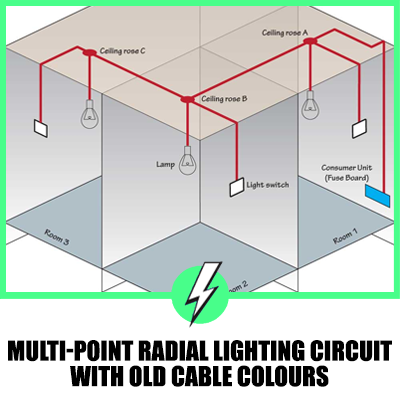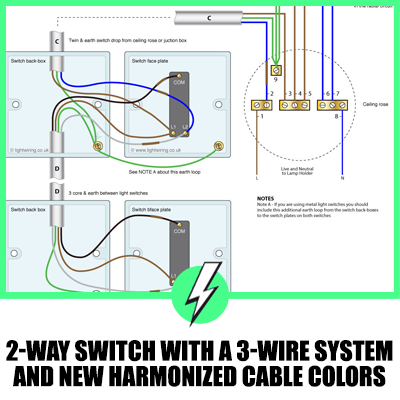Multi-Point Radial Lighting Circuit with Old Cable Colours
Curious about how the multi-point radial lighting circuit functioned before the introduction of new cable colours in the UK?
This traditional electrical wiring setup was a cornerstone in British homes, providing an efficient way to distribute power to multiple lighting points from a single source.
The advent of updated wiring regulations brought changes, but the fundamental principles of the multi-point radial lighting circuit, along with its old cable colours, remain a significant part of electrical history.
This article will take you through the intricacies of this system, highlighting the old cable colour scheme and its role in electrical installations.
Well, we’ll be going over:
- How was the multi-point radial lighting circuit configured using the old cable colours?
- What were the old cable colours, and what did they signify?
- How has the transition to new cable colours impacted the understanding and modification of electrical circuits?
By exploring these questions, you’ll gain a deeper appreciation for the evolution of electrical standards and practices.
Let’s dive into the past to understand the roots of modern electrical wiring!

Contents
Overview of the Multi-Point Radial Lighting Circuit
The multi-point radial lighting circuit with old cable colours was designed to supply power to various lighting fixtures from a central source.
It featured a circuit arrangement where lighting points were connected in a radial manner, branching off directly from the main circuit cable.
This configuration facilitated the distribution of electricity to different lighting points throughout a building or room.
Fig 1 shows what is referred to as a radial circuit (sometimes called a ‘loop-in’ or ‘multi-point radial lighting circuit’).
Fig 1: multi point (loop-in) radial lighting circuit
The live feed from the Consumer unit (fuse board, shown in blue in Fig 1) feeds into the first ceiling rose (ceiling rose A, Fig 1).
This would be cable A in the diagram below (Fig 2) which shows how the ceiling rose is terminated.
This live feed now loops back out of the rose (cable B, Fig 2) and feeds power to the next ceiling light in the radial circuit (Ceiling rose B, Fig 1).
This repeats for each light in the circuit until we reach the last light.
Once we reach the last light, you can see that there is only The feed from ceiling rose B (Fig 1), This is Cable A in the diagram below (Fig 3), which show how the last ceiling rose in the circuit is terminated.

Fig 2: Ceiling rose (old cable colours)
Notice that each of the three ceiling roses in Fig 1 has, in addition to the power feeds, an additional cable that feeds down to the light switches (the switch wire).
This the Cable C in fig 2 & Fig 3.

Fig 3: Radial circuit last ceiling rose in the circuit (old colours)
Key Components and Connections
- Consumer Unit: The circuit originated from the consumer unit, where the lighting circuit was connected to a dedicated circuit breaker or fuse for protection.
- Circuit Cable: The circuit cable, typically a three-core cable with specific colours for each core, carried the electrical supply from the consumer unit to the lighting points.
- Live: Red
- Neutral: Black
- Earth: Green/Yellow
- Lighting Points: Individual cables connected each lighting point to the circuit cable, enabling power distribution to various fixtures.
- Switches: Switches were installed at each lighting point to control the on/off operation of the connected fixtures.
Advantages of the Multi-Point Radial Lighting Circuit:
- Simplicity and Cost-effectiveness: The multi-point radial lighting circuit with old cable colours was relatively straightforward to install and was a cost-effective option compared to alternative wiring configurations.
- Flexibility: This circuit layout allowed for the addition or removal of lighting points without impacting the rest of the circuit, offering flexibility in lighting design and future modifications.
- Efficient Power Distribution: The radial layout minimized voltage drops, ensuring consistent and reliable lighting performance across all connected fixtures.
Transition to New Cable Colours
In recent years, the UK has transitioned to new cable colours as part of updated wiring regulations.
The previous red (live), black (neutral), and green/yellow (earth) cable colours have been replaced by a harmonized set of colours:
- Live: Brown
- Neutral: Blue
- Earth: Green and yellow striped
It is essential to note that the transition to new cable colours improves safety and conformity in electrical installations, enhancing consistency and standardization across the industry.
Conclusion
The multi-point radial lighting circuit with old cable colours was a widely used electrical wiring configuration in the UK.
By understanding its key components, connections, and the old cable colours used, individuals can gain insights into historical electrical installations.
Although the wiring regulations have since been updated, it is important to recognize the evolution of electrical systems and remain compliant with the current standards when installing or modifying lighting circuits.
The multi-point radial lighting circuit, with its simplicity, flexibility, and efficient power distribution, served as a reliable choice for lighting installations in residential and commercial settings during its time.




